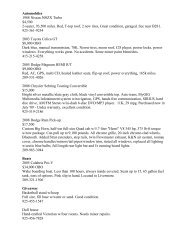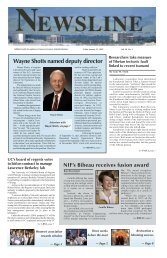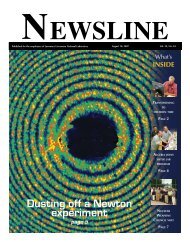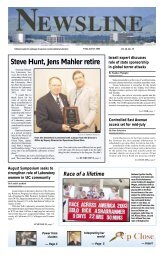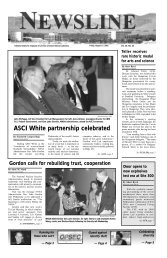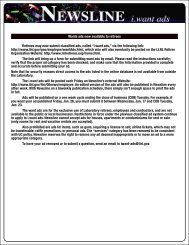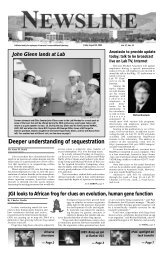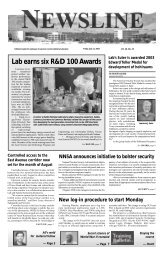New Laboratory counsel selected - NEWSLINE - Lawrence ...
New Laboratory counsel selected - NEWSLINE - Lawrence ...
New Laboratory counsel selected - NEWSLINE - Lawrence ...
Create successful ePaper yourself
Turn your PDF publications into a flip-book with our unique Google optimized e-Paper software.
Friday, June 10, 2005<br />
COCHRAN<br />
Continued from page 1<br />
Security Organization since<br />
October, plans to leave<br />
LLNL on June 29.<br />
“I’ve worked with great<br />
people at the <strong>Laboratory</strong>;<br />
there’s been a willingness to<br />
take risks and a willingness<br />
to push people to accomplish<br />
their best,” Cochran said.<br />
In accepting Cochran’s<br />
retirement, Lab Director<br />
Michael Anastasio remarked,<br />
“I have known and personally<br />
worked with Steve my<br />
entire career — first as my<br />
division leader and early<br />
mentor in B Division, and<br />
now as a member of my management<br />
team. Our careers<br />
have intersected throughout<br />
this time frame. Steve has a<br />
combination of technical<br />
acumen, sharp wit and great<br />
passion for our national<br />
security mission. He was<br />
there in the beginning — to<br />
launch the formation and<br />
growth of NAI — and most<br />
recently in the establishment<br />
of our roles for homeland<br />
security. I wish him only the<br />
best for the future.”<br />
Wayne Shotts, the former NAI associate<br />
director and present Lab deputy director for<br />
Operations, noted, “Steve has been a tremendous<br />
contributor at the <strong>Laboratory</strong>. Since our days together<br />
at Cornell our careers have crossed paths many<br />
times. Most recently, Steve’s energy, technical<br />
breadth, and outstanding leadership skills have been<br />
critical to taking NAI and HSO from start-up organizations<br />
to major components of the Lab.”<br />
A Lab employee for more than 30 years, he started<br />
in NAI within a month of the new directorate’s<br />
formation in 1992 by then-Lab Director John<br />
Nuckolls, who picked Bob Andrews as the organization’s<br />
first associate director.<br />
Cochran has continued to work in NAI for the<br />
past 13 years, holding a number of positions, including<br />
serving for the past 10 years as its deputy associate<br />
director for Programs.<br />
“My role has been to coordinate and integrate the<br />
range of programs within NAI into a single strategy.<br />
Our aim, through our four divisions, has been to prevent<br />
proliferation and terrorism (P Division), detect<br />
and reverse it (Q division), respond (R Division) and<br />
DNA<br />
Continued from page 1<br />
of DNA that interact with the proteins that help<br />
control gene expression, can be a long distance<br />
on the DNA strand from the genes they influence.<br />
Recent research also has shown that gene<br />
expression can be controlled by several regulatory<br />
proteins working together at a combination<br />
of different binding sites.<br />
Regulatory proteins are known as “transcription<br />
factors”; transcription is the first step<br />
in the process by which the genetic information<br />
in DNA is decoded by the cell to manufacture<br />
proteins, the building blocks of life.<br />
“It’s difficult to experimentally observe<br />
how transcription factors bind to DNA at a distance<br />
from a gene, or how regulation happens,”<br />
said Krzysztof Fidelis, a computational biologist<br />
in the <strong>Laboratory</strong>’s Biosciences<br />
Directorate. “But you can identify their binding<br />
sites in a promoter or regulatory region —<br />
there are usually a few of these for each gene.<br />
We wanted to see if we could somehow deduce<br />
how many transcription factors at a time, or<br />
combinations of factors, are coming together<br />
physically and how these combinations regu-<br />
avoid surprise (Z Division),” Cochran said.<br />
“While NAI was formed to combat the proliferation<br />
of weapons of mass destruction by both<br />
states and non-state groups, the organization’s<br />
establishment made it natural for the directorate<br />
to extend its capabilities to homeland security,”<br />
Cochran said.<br />
Factors highlighting the need for fighting terrorism,<br />
in Cochran’s view, include the concern over<br />
nuclear materials with the break-up of the former<br />
Soviet Union, the nerve gas attack by the Aum<br />
Shinrikyo cult in Tokyo and later, the Sept. 11, 2001<br />
World Trade Center attack, which he termed “a<br />
defining event.”<br />
“The World Trade Center attack changed our<br />
security perception dramatically enough about<br />
our own security — things that weren’t previously<br />
thought possible became possible.”<br />
Since its inception, NAI has grown significantly,<br />
from a budget of about $60 million and<br />
255 employees in 1992 to its current budget of<br />
more than $300 million and some 865 employees.<br />
The challenge in growing the program,<br />
late genes.”<br />
“To accomplish this,” said the LCB’s Jan<br />
Komorowski, “we used a machine learning<br />
technique called rough sets to mathematically<br />
model general rules that could associate known<br />
binding sites and gene expression in yeast,<br />
which is one of the most widely studied organisms.”<br />
From the analysis of gene activity under<br />
a variety of environmental conditions, the<br />
teams were able to develop a set of rules for<br />
predicting the location of binding site combinations<br />
based on limited binding site and gene<br />
expression data.<br />
“We found that the same transcription factors,<br />
in slightly different combinations, could<br />
be responsible for the regulation of different<br />
genes,” said Torgeir R. Hvidsten of the LCB.<br />
“Thus we now know that binding sites can be<br />
combined to allow a large number of expression<br />
outcomes using relatively few transcription<br />
factors.”<br />
Others collaborating in the project were<br />
Jerzy Tiuryn of the Faculty of Mathematics,<br />
Informatics, and Mechanics at Warsaw<br />
University in Poland; Bartosz Wilczynski of<br />
the Institute of Mathematics, Polish Academy<br />
of Sciences, and LLNL; and Andriy<br />
<strong>New</strong>sline 7<br />
said Cochran, has been to have<br />
smart growth — growth that is<br />
synergistic with the organization’s<br />
strategic vision.<br />
“We’ve tried to bring in projects<br />
that are consistent with our<br />
vision and mission for the organization.<br />
We had to figure out who<br />
we were and what we were good<br />
at.”<br />
Cochran came to LLNL in<br />
1974, joining the Weapons<br />
Program’s B Division, where he<br />
worked as a physicist doing code<br />
development for six years. Next<br />
he served as the associate division<br />
leader for computational<br />
physics in A Division and then as<br />
high explosives technology<br />
leader in the Chemistry and<br />
Materials Science Department.<br />
He also was the leader of B<br />
Division for seven years and<br />
then deputy associate director for<br />
Defense Systems and Nuclear<br />
Design for one year before moving<br />
to NAI.<br />
Cochran was named to his current<br />
positions last October<br />
when NAI associate director<br />
and acting director of LLNL’s<br />
Homeland Security Organization,<br />
Wayne Shotts, was<br />
tapped to be the Lab’s acting<br />
deputy director of Operations, a position he now<br />
holds.<br />
During his Lab career, Cochran’s highlights<br />
include the development of a material model for<br />
high explosives, an important contribution to<br />
nuclear explosive safety, a contribution to a<br />
weapons component and his work in NAI.<br />
“I can’t take credit for hiring Mike<br />
Anastasio, but I can take credit for giving him<br />
his first two promotions at the Lab,” Cochran<br />
said.<br />
His main reason for retiring, he said, is so he<br />
and his wife, Cynthia, can move to the East<br />
Coast to live near their three children, Stephen<br />
Jr., Meredith and James, and their two grandchildren.<br />
He also believes the timing is right for the<br />
directorate.<br />
“Change is good,” Cochran said. “I’ve been at<br />
the Lab a very long time and I’ve certainly enjoyed<br />
my tenure in NAI. But there are a lot of new ideas<br />
out there and it’s time to let those emerge. I look<br />
forward to seeing all the great things that can and<br />
will happen with this directorate.”<br />
JACQUELINE MCBRIDE/<strong>NEWSLINE</strong><br />
Former P Division leader and retiree Bill Dunlop (left) shares a laugh with Steve Cochran,<br />
the acting associate director for NAI who is retiring June 29, and his wife, Cynthia, during a<br />
retirement celebration in Bldg. 132S Thursday afternoon.<br />
Kryshtafovych of LLNL. A report on the joint<br />
work appears in the June issue of the journal<br />
Genome Research.<br />
The rough set technique was developed by<br />
Zdzislaw Pawlak in Poland in the 1980s and is<br />
particularly suitable to build models from<br />
incomplete and uncertain data. It has been<br />
used in applications ranging from medical<br />
and financial data analysis to voice recognition<br />
and image processing. Applied to gene<br />
regulation, the approach was able to predict<br />
the location of regulatory sites for about onethird<br />
of the genes in the yeast genome — a<br />
success rate as good as or better than other<br />
current techniques.<br />
“The next step is to test this approach on<br />
different organisms, including microbes and<br />
vertebrates,” Fidelis said. The growing number<br />
of organisms whose genomes have been<br />
sequenced has generated a wealth of DNA<br />
sequence information that could provide the<br />
raw material for analysis.<br />
Primary funding for the research was provided<br />
by LLNL’s <strong>Laboratory</strong> Directed<br />
Research and Development Program, the Knut<br />
and Alice Wallenberg Foundation, and the<br />
Swedish Foundation for Strategic Research.



